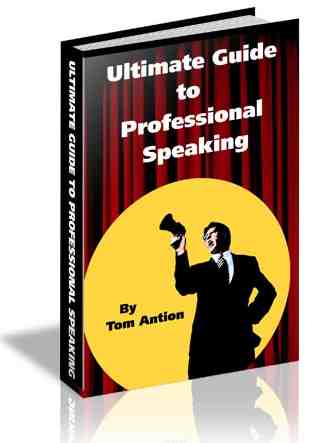Public Speaking:
Glossary A - E
- Public Speaking Glossary F - J
- Public Speaking Glossary K - O
- Public Speaking Glossary P - T
- Public Speaking Glossary U - Z
Acronym: A form of abbreviation where the letters of the abbreviation form a new word as in HUD for The Department of Housing and Urban Development.
Ad-lib: Unplanned words or phrases spoken during a presentation.
Alliteration: The repetition of the same first sound or the same first letter in a group of words or line of poetry as in from stem to stern.
Anachronism: A person, place, or event that is placed in a time period in which it does not belong such as George Washington sitting in front of a computer.
Analogy: A comparison of two things that are alike in some ways and different in others. An example is your brain is similar to a computer.
Anecdote: A short interesting or amusing incident.
Aside: In the theater, something said to the audience that is not to be heard by the other actors. In television, the actor would look right at the camera and talk to the viewers. In a presentation, the speaker would make a temporary departure from the main theme or topic.
Attribution: Crediting the source of material used in a presentation.
Audience gag: A joke pulled on the audience, sometimes with some of the audience members used as shills.
Audience participation: The audience doing something other than listeningduring
a public speaking engagement. Some of them could be on-stage with you, carrying on group discussions, playing games, singing, etc.
A/V: Abbreviation for audiovisual equipment, such as overhead projectors, tape recorders, slide projectors, microphones, etc.
Bits: A short section of material so related that it is easy to memorize. Also called Chunks, Series.
Black Humor: According to Webster's Dictionary, "Humor that ignores human suffering and looks for the absurdity in any experience, even the most tragic." Used as a stress reliever in many high pressure occupations (medicine, law enforcement, military, etc.). Also Sick humor, Gallows humor. (Note: Please don't use in a professional presentation)
Blocking: Positioning of you and your equipment on the stage. Also your intended movement on the stage.
Blooper: A clumsy mistake, especially one made in public; a faux pas.
Blue Humor: Risque or dirty humor The kind of humor everyone likes, but won't admit it. (OK, I'm kidding or am I?) Also called Off-color humor.
Bomb: In the USA a GIANT failure. In Great Britain a smashing success.
Bombproofing: Term coined by your lovable author to signify the steps you take as a presenter to be sure you don't bomb.
Breakout session: Splitting the entire group into smaller groups to hear special interest
public speaking topics.
Callback: Referring to a word or phrase you mentioned earlier in your presentation.
Canned act: The use of standard material regardless of the makeup of the audience (not customized). Also Planned Spontaneity.
Canned ad-lib: Pre-planned response to a presentation problem or audience member comment.
Caricature: A picture in which the subject's distinctive features are deliberately exaggerated to produce a comic or grotesque effect.
Cartoon: An illustrated joke. Also Comic Strip.
Cheap laugh: Simple, sometimes tasteless, laughs that anyone, regardless of skill level, could elicit from the audience
during a public speaking engagement (this is my specialty Ha-ha).
Chunks: See Bits.
Classroom seating: Seating style where chairs are placed behind tables.
Cliche: A worn-out saying such as "It's better to be safe than sorry" (that's a sorry cliche).
Comeback: A humorous or clever retort to an audience comment. Also Repartee or Riposte.
Comedian: An amusing person whose primary purpose is to entertain. Also Comic.
Comedienne: Older, less politically correct, term for a female comedian.
Comic: See Comedian.
Comic relief: An amusing element introduced into a serious speech or play to temporarily relieve tension.
Comic strip: Cartoon progressing over a series of scenes.
Concurrent session: A session occurring at the same time as another (breakout) session.
Content: The usable information in a presentation.
Convulsive laughter: Violent laughter that causes a person to lunge forward, backward or both.
Cordless microphone: A microphone which works by transmitting radio signals to a receiver which is connected to the public address (PA) system. Also Wireless Microphone.
Custom humor: Humorous comments, skits, role playing, gags, or costuming devised specifically for a particular audience.
Dais: A raised platform in the front of the room where the speaker stands. Also Podium, Riser, Stage or Platform.
Deadpan expression: A serious expression contrasted with funny lines.
Demo tape: An audio or video tape used to promote speakers, bands, magicians, etc.
Downstage: The area of the stage closest to the audience.
Dynamic range: Gradation of intensity available for use by a presenter from demure whisper to boisterous screams.
Easel: A tripod or frame used to support flipchart pads or other visuals.
Emcee: Abbrev. MC, An informal term for Master of Ceremonies. Also Toastmaster, Roastmaster.
Exaggeration humor: Expanding or diminishing features or information to outrageous proportions for comic effect.
Extemporaneous: An impromptu or spontaneous presentation.
Extender line: Line added to the end of a humorous comment that evokes additional laughter.
(Public Speaking Glossary A - E) Click
here for Public Speaking F - J






